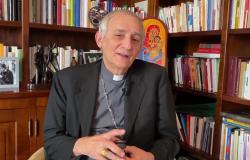Diego Rodríguez de Silva y Velázquez, known as Diego Velázquez, was the most important artist at the court of King Philip IV, among the greatest of the Baroque era and an extraordinary portraitist. In this period in Italy it is possible to admire some of his masterpieces thanks to loans from prestigious European museums.
One of the most talented painters of all time, Velázquez (6 June 1599, Seville – 6 August 1660, Madrid) was an international artist, and he visited Rome twice throughout his life and like Rubens he had a privileged relationship with Rome and Italy. His first trip to Italy dates back to the years between 1629 and 1631, when he spent a year and a half there with the intention of seeing and studying the works of art present in the country. He then returned to Italy also in 1649.
In those years it is well known that the evolution of painting was revolutionized by Michelangelo Merisi da Caravaggio (1571-1610), ever since his first canvases were revealed to the public, giving rise to the phenomenon of Caravaggismwhich within a few years became European in scope, influencing Flemish, Dutch, French and Spanish painters.
Even for Diego Velázquez the long-distance bond with Caravaggio was strong and today it lives again Romeat the Borghese Gallery until June 23rdthanks to the exceptional loan from Woman in the kitchen with Supper at Emmaus coming from the permanent collection of National Gallery of Ireland in Dublinset up in the same room as Caravaggio’s paintings. The initiative therefore creates a precious opportunity to deepen this intense cultural dialogue between Masters.
Also Naples is currently hosting an important exhibition event dedicated to the great Spanish painter, thanks to the initiative of Galleries of ItalyIntesa Sanpaolo museum. Until July 14, 2024 it is in fact possible to admire it two masterpieces by Diego Velázquez from from the National Gallery in London. It’s about Immaculate Conception And Saint John the Evangelist on the island of Patmos. For the occasion of “Velázquez. A great sign“, the two paintings by Velázquez are exhibited alongside two other paintings depicting theImmaculate Conceptionby Paolo Finoglio, coming from the Franciscan convent of San Lorenzo Maggiore in Naples and by Battistello Caracciolo preserved in the church of the Nativity of the Blessed Virgin Mary in Roccadaspide, in Cilento.
The arrival of the works from the National Gallery in London took place on the occasion of the London exhibition ‘The Last Caravaggio‘ where the work is the protagonist The Martyrdom of Saint Ursula on loan from Intesa Sanpaolo.
Diego Velázquez in Italian museums
Outside of temporary exhibitions, in Italy there are some masterpieces by Velázquez in prestigious Italian museums, starting from the Uffizi Gallery (watch the video). The Uffizi collection includes one of his self-portrait from 1643. The painting required careful restoration after it was damaged during the flood of 1966. Another work by Velázquez present in the Uffizi collection is The Water Bearer of Sevilledatable to 1618-19, therefore before the version preserved in the Victoria and Albert Museum in London.
Another work by Velázquez present in Italy is the Portrait of Juan de Córdoba from 1650, belonging to the collection of Capitoline Museums. Known as Portrait of a manreported since the first guides of the Capitoline Art Gallery to Diego Velázquez, the subject of the painting was attributed with certainty only after recent studies.… read the rest of the article”
Diego Velázquez, Portrait of Juan de Córdoba, collection of the Capitoline Museums (detail)
Velázquez is still present in Rome in the collection of Casino dell’Aurora Pallavicinione of the most important Roman collections hosted in Palazzo Pallavicini Rospigliosiand with the most important piece of the entire collection of Doria Pamphilj GalleryThe Portrait of Pope Innocent, an absolute masterpiece of 17th century portraiture. Velázquez probably executed it between the end of 1649 and January 1650, at a time of great international political changes, when, after the Peace of Westphalia (1648), the papacy was drawing closer to Habsburg Spain, abandoning the pro-French line.

Diego Velázquez, Portrait of Pope Innocent Oil on canvas, 141 × 119 cm – Galleria Doria Pamphilj, Rome
Also Modenawith her Estense Gallery, boasts a portrait of Diego Velázquez in its collection. It’s about the Portrait of Francesco I d’Este, an oil on canvas dated 1638-39. The painting represents the Duke of Modena, Francesco I d’Este, and was created in the period in which the duke was visiting the royal house of Spain, the occasion on which the sovereign awarded the duke the honor of the golden fleece which appears in the portrait. The portrait can boast an exhibition at the Metropolitan Museum of Art in New York, from 16 April to 14 July 2013.
Not directly attributed to the Spanish master, the painting preserved at National Gallery of Puglia “Girolamo and Rosaria Devanna”, art gallery based in the Sylos-Calò palace Bitonto. Here is the painting “Portrait of a man with a mustache and goatee“, with an uncertain dating, between 1640 and 1660, attributable to the cultural and artistic area linked to the figure of Diego Velázquez (manner). An inscription placed on the original canvas (removed) bore the name of the character depicted, of nationality Spanish (com. or. Devanna Girolamo).
Link for further information:
Your registration cannot be validated.
Your registration was successful.
Editorial board
Published on 04/28/2024
Itinerarinellarte.it






